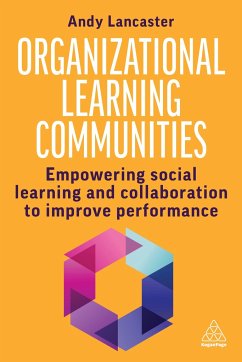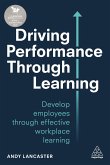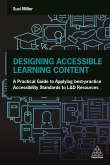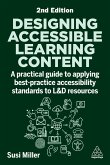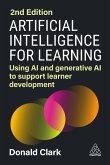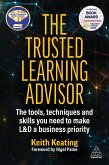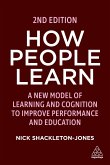Andy Lancaster
Organizational Learning Communities
Empowering Social Learning and Collaboration to Improve Performance
Andy Lancaster
Organizational Learning Communities
Empowering Social Learning and Collaboration to Improve Performance
- Broschiertes Buch
- Merkliste
- Auf die Merkliste
- Bewerten Bewerten
- Teilen
- Produkt teilen
- Produkterinnerung
- Produkterinnerung
Understand how to build and foster learning communities in your organization to drive individual employee and overall business performance.
Andere Kunden interessierten sich auch für
![Driving Performance through Learning Driving Performance through Learning]() Andy LancasterDriving Performance through Learning27,99 €
Andy LancasterDriving Performance through Learning27,99 €![Designing Accessible Learning Content Designing Accessible Learning Content]() Susi MillerDesigning Accessible Learning Content61,99 €
Susi MillerDesigning Accessible Learning Content61,99 €![Designing Accessible Learning Content Designing Accessible Learning Content]() Susi MillerDesigning Accessible Learning Content61,99 €
Susi MillerDesigning Accessible Learning Content61,99 €![Artificial Intelligence for Learning Artificial Intelligence for Learning]() Donald ClarkArtificial Intelligence for Learning32,99 €
Donald ClarkArtificial Intelligence for Learning32,99 €![The Trusted Learning Advisor The Trusted Learning Advisor]() Keith KeatingThe Trusted Learning Advisor29,99 €
Keith KeatingThe Trusted Learning Advisor29,99 €![How People Learn How People Learn]() Nick Shackleton-JonesHow People Learn30,99 €
Nick Shackleton-JonesHow People Learn30,99 €![Armstrong's Essential Skills for People Professionals Armstrong's Essential Skills for People Professionals]() Michael ArmstrongArmstrong's Essential Skills for People Professionals26,99 €
Michael ArmstrongArmstrong's Essential Skills for People Professionals26,99 €-
-
-
Understand how to build and foster learning communities in your organization to drive individual employee and overall business performance.
Hinweis: Dieser Artikel kann nur an eine deutsche Lieferadresse ausgeliefert werden.
Hinweis: Dieser Artikel kann nur an eine deutsche Lieferadresse ausgeliefert werden.
Produktdetails
- Produktdetails
- Verlag: Kogan Page Ltd
- Seitenzahl: 448
- Erscheinungstermin: 25. Juni 2024
- Englisch
- Abmessung: 232mm x 154mm x 35mm
- Gewicht: 688g
- ISBN-13: 9781398615496
- ISBN-10: 1398615498
- Artikelnr.: 68916953
- Herstellerkennzeichnung
- Libri GmbH
- Europaallee 1
- 36244 Bad Hersfeld
- gpsr@libri.de
- Verlag: Kogan Page Ltd
- Seitenzahl: 448
- Erscheinungstermin: 25. Juni 2024
- Englisch
- Abmessung: 232mm x 154mm x 35mm
- Gewicht: 688g
- ISBN-13: 9781398615496
- ISBN-10: 1398615498
- Artikelnr.: 68916953
- Herstellerkennzeichnung
- Libri GmbH
- Europaallee 1
- 36244 Bad Hersfeld
- gpsr@libri.de
Andy Lancaster
Section
01: What are the foundations for organizational learning communities? Chapter
01: Natural tendencies Chapter
02: Better together Chapter
03: Social learning theory
Bandura Chapter
04: Social constructivist and scaffolding
Vygotsky and Bruner Chapter
05: Situated learning theory
Lave and Wenger Chapter
06: Collective, collaborative, or cooperative? Chapter
07: The elusive 20 Chapter
08: Community definitions Chapter
09: DNA of learning communities Chapter
10: Community dimensions Section
02: How are organizational learning communities impactful? Chapter
11: Sharing knowledge Chapter
12: Spearheading practice Chapter
13: Solving problems Chapter
14: Seeding innovation Chapter
15: Supercharging development Section
03: What are keys to facilitate effective organizational learning communities? The 7Cs model Chapter
16: Introducing the 7Cs model Chapter
17: Friction Chapter
18: Attraction Chapter
19: Ownership Chapter
20: Charters Chapter
21: Access Chapter
22: Sponsor
champions Chapter
23: Launch Chapter
24: Context and culture Chapter
25: Rituals Chapter
26: Psychology safety Chapter
27: Inclusivity and intersectionality Chapter
28: Altruism Chapter
29: Bias: Information and interpretation Chapter
30: Bias: Interaction and image Chapter
31: Groupthink Chapter
32: The spiral community Chapter
33: Balancing modes: Face
to
face, digital and hybrid Chapter
34: Levering physical spaces Chapter
35: Leveraging digital spaces: LMS and LXP Chapter
36: Levering digital spaces: Tools Chapter
37: Leveraging virtual spaces: Metaverse worlds Chapter
38: Ensuring accessibility Chapter
39: Rhythms Chapter
40: Cadence Chapter
41: Phases Chapter
42: Synchronous
Asynchronous Chapter
43: Shelf life Chapter
44: Curating assets Chapter
45: Creative activities Chapter
46: Coordinated campaigns Chapter
47: Curious questioning Chapter
48: Cultivating AI Chapter
49: Passivity to participation Chapter
50: Numbers Chapter
51: Relationship and contribution analysis Chapter
52: Working out loud Chapter
53: Task contributions Chapter
54: Social contributions Chapter
55: Dysfunctional contributions Chapter
56: Coordination and management Chapter
57: Recognition and reward Chapter
58: Roles Section
04: How can we demonstrate the impact of organizational learning communities? Chapter
59: Quantitative, qualitative, ROI and ROE Chapter
60: Participant reflection and the five cycles model Chapter
61: Leveraging narratives
01: What are the foundations for organizational learning communities? Chapter
01: Natural tendencies Chapter
02: Better together Chapter
03: Social learning theory
Bandura Chapter
04: Social constructivist and scaffolding
Vygotsky and Bruner Chapter
05: Situated learning theory
Lave and Wenger Chapter
06: Collective, collaborative, or cooperative? Chapter
07: The elusive 20 Chapter
08: Community definitions Chapter
09: DNA of learning communities Chapter
10: Community dimensions Section
02: How are organizational learning communities impactful? Chapter
11: Sharing knowledge Chapter
12: Spearheading practice Chapter
13: Solving problems Chapter
14: Seeding innovation Chapter
15: Supercharging development Section
03: What are keys to facilitate effective organizational learning communities? The 7Cs model Chapter
16: Introducing the 7Cs model Chapter
17: Friction Chapter
18: Attraction Chapter
19: Ownership Chapter
20: Charters Chapter
21: Access Chapter
22: Sponsor
champions Chapter
23: Launch Chapter
24: Context and culture Chapter
25: Rituals Chapter
26: Psychology safety Chapter
27: Inclusivity and intersectionality Chapter
28: Altruism Chapter
29: Bias: Information and interpretation Chapter
30: Bias: Interaction and image Chapter
31: Groupthink Chapter
32: The spiral community Chapter
33: Balancing modes: Face
to
face, digital and hybrid Chapter
34: Levering physical spaces Chapter
35: Leveraging digital spaces: LMS and LXP Chapter
36: Levering digital spaces: Tools Chapter
37: Leveraging virtual spaces: Metaverse worlds Chapter
38: Ensuring accessibility Chapter
39: Rhythms Chapter
40: Cadence Chapter
41: Phases Chapter
42: Synchronous
Asynchronous Chapter
43: Shelf life Chapter
44: Curating assets Chapter
45: Creative activities Chapter
46: Coordinated campaigns Chapter
47: Curious questioning Chapter
48: Cultivating AI Chapter
49: Passivity to participation Chapter
50: Numbers Chapter
51: Relationship and contribution analysis Chapter
52: Working out loud Chapter
53: Task contributions Chapter
54: Social contributions Chapter
55: Dysfunctional contributions Chapter
56: Coordination and management Chapter
57: Recognition and reward Chapter
58: Roles Section
04: How can we demonstrate the impact of organizational learning communities? Chapter
59: Quantitative, qualitative, ROI and ROE Chapter
60: Participant reflection and the five cycles model Chapter
61: Leveraging narratives
Section
01: What are the foundations for organizational learning communities? Chapter
01: Natural tendencies Chapter
02: Better together Chapter
03: Social learning theory
Bandura Chapter
04: Social constructivist and scaffolding
Vygotsky and Bruner Chapter
05: Situated learning theory
Lave and Wenger Chapter
06: Collective, collaborative, or cooperative? Chapter
07: The elusive 20 Chapter
08: Community definitions Chapter
09: DNA of learning communities Chapter
10: Community dimensions Section
02: How are organizational learning communities impactful? Chapter
11: Sharing knowledge Chapter
12: Spearheading practice Chapter
13: Solving problems Chapter
14: Seeding innovation Chapter
15: Supercharging development Section
03: What are keys to facilitate effective organizational learning communities? The 7Cs model Chapter
16: Introducing the 7Cs model Chapter
17: Friction Chapter
18: Attraction Chapter
19: Ownership Chapter
20: Charters Chapter
21: Access Chapter
22: Sponsor
champions Chapter
23: Launch Chapter
24: Context and culture Chapter
25: Rituals Chapter
26: Psychology safety Chapter
27: Inclusivity and intersectionality Chapter
28: Altruism Chapter
29: Bias: Information and interpretation Chapter
30: Bias: Interaction and image Chapter
31: Groupthink Chapter
32: The spiral community Chapter
33: Balancing modes: Face
to
face, digital and hybrid Chapter
34: Levering physical spaces Chapter
35: Leveraging digital spaces: LMS and LXP Chapter
36: Levering digital spaces: Tools Chapter
37: Leveraging virtual spaces: Metaverse worlds Chapter
38: Ensuring accessibility Chapter
39: Rhythms Chapter
40: Cadence Chapter
41: Phases Chapter
42: Synchronous
Asynchronous Chapter
43: Shelf life Chapter
44: Curating assets Chapter
45: Creative activities Chapter
46: Coordinated campaigns Chapter
47: Curious questioning Chapter
48: Cultivating AI Chapter
49: Passivity to participation Chapter
50: Numbers Chapter
51: Relationship and contribution analysis Chapter
52: Working out loud Chapter
53: Task contributions Chapter
54: Social contributions Chapter
55: Dysfunctional contributions Chapter
56: Coordination and management Chapter
57: Recognition and reward Chapter
58: Roles Section
04: How can we demonstrate the impact of organizational learning communities? Chapter
59: Quantitative, qualitative, ROI and ROE Chapter
60: Participant reflection and the five cycles model Chapter
61: Leveraging narratives
01: What are the foundations for organizational learning communities? Chapter
01: Natural tendencies Chapter
02: Better together Chapter
03: Social learning theory
Bandura Chapter
04: Social constructivist and scaffolding
Vygotsky and Bruner Chapter
05: Situated learning theory
Lave and Wenger Chapter
06: Collective, collaborative, or cooperative? Chapter
07: The elusive 20 Chapter
08: Community definitions Chapter
09: DNA of learning communities Chapter
10: Community dimensions Section
02: How are organizational learning communities impactful? Chapter
11: Sharing knowledge Chapter
12: Spearheading practice Chapter
13: Solving problems Chapter
14: Seeding innovation Chapter
15: Supercharging development Section
03: What are keys to facilitate effective organizational learning communities? The 7Cs model Chapter
16: Introducing the 7Cs model Chapter
17: Friction Chapter
18: Attraction Chapter
19: Ownership Chapter
20: Charters Chapter
21: Access Chapter
22: Sponsor
champions Chapter
23: Launch Chapter
24: Context and culture Chapter
25: Rituals Chapter
26: Psychology safety Chapter
27: Inclusivity and intersectionality Chapter
28: Altruism Chapter
29: Bias: Information and interpretation Chapter
30: Bias: Interaction and image Chapter
31: Groupthink Chapter
32: The spiral community Chapter
33: Balancing modes: Face
to
face, digital and hybrid Chapter
34: Levering physical spaces Chapter
35: Leveraging digital spaces: LMS and LXP Chapter
36: Levering digital spaces: Tools Chapter
37: Leveraging virtual spaces: Metaverse worlds Chapter
38: Ensuring accessibility Chapter
39: Rhythms Chapter
40: Cadence Chapter
41: Phases Chapter
42: Synchronous
Asynchronous Chapter
43: Shelf life Chapter
44: Curating assets Chapter
45: Creative activities Chapter
46: Coordinated campaigns Chapter
47: Curious questioning Chapter
48: Cultivating AI Chapter
49: Passivity to participation Chapter
50: Numbers Chapter
51: Relationship and contribution analysis Chapter
52: Working out loud Chapter
53: Task contributions Chapter
54: Social contributions Chapter
55: Dysfunctional contributions Chapter
56: Coordination and management Chapter
57: Recognition and reward Chapter
58: Roles Section
04: How can we demonstrate the impact of organizational learning communities? Chapter
59: Quantitative, qualitative, ROI and ROE Chapter
60: Participant reflection and the five cycles model Chapter
61: Leveraging narratives

